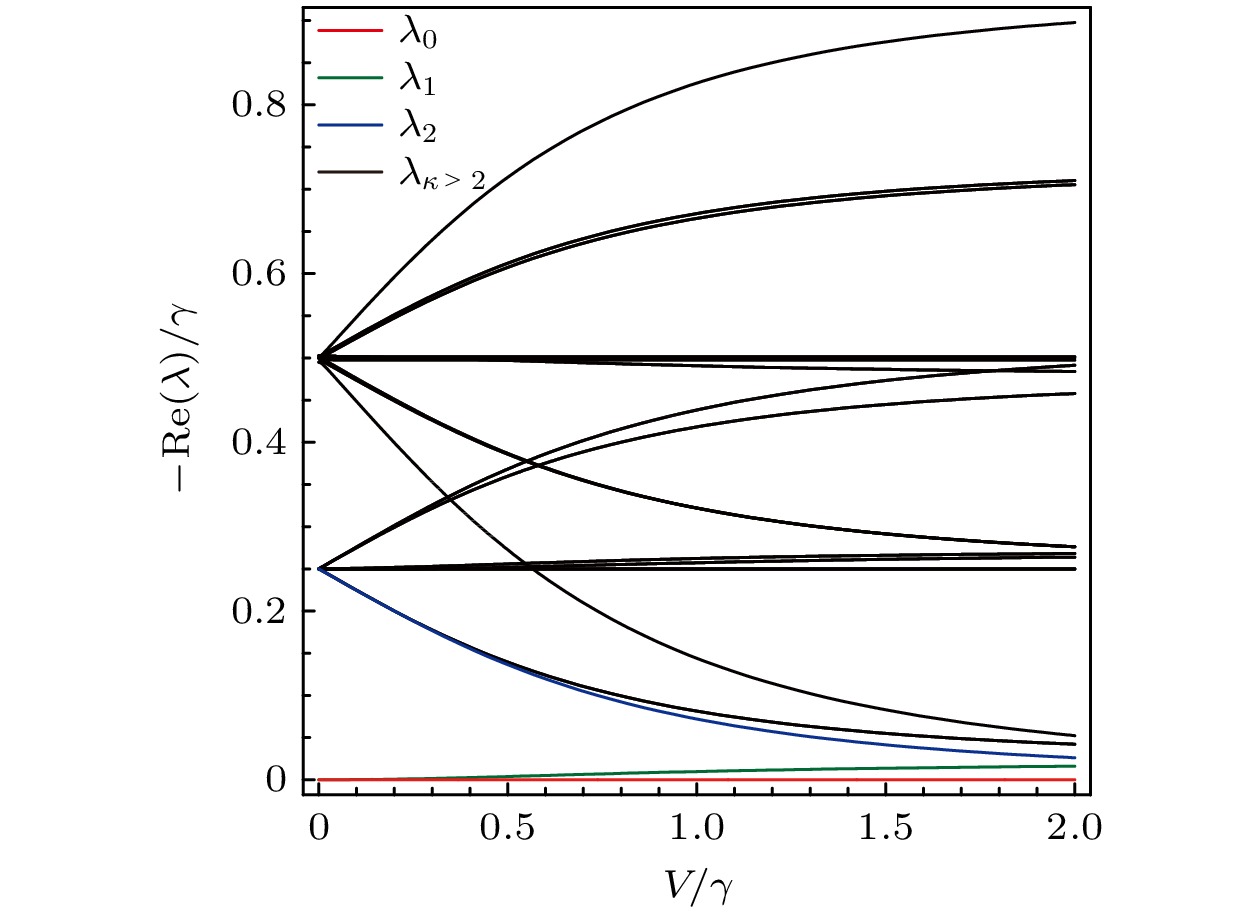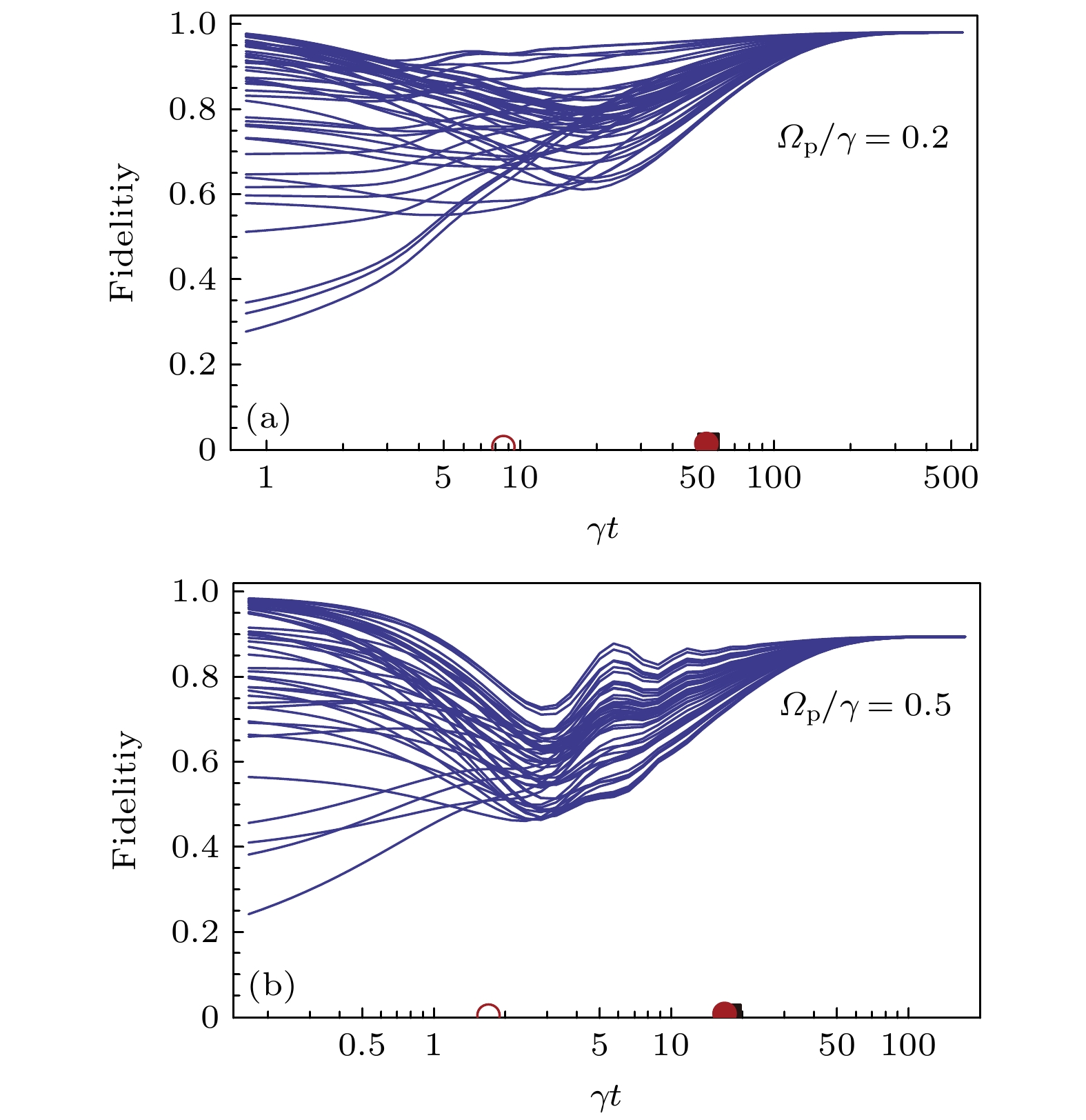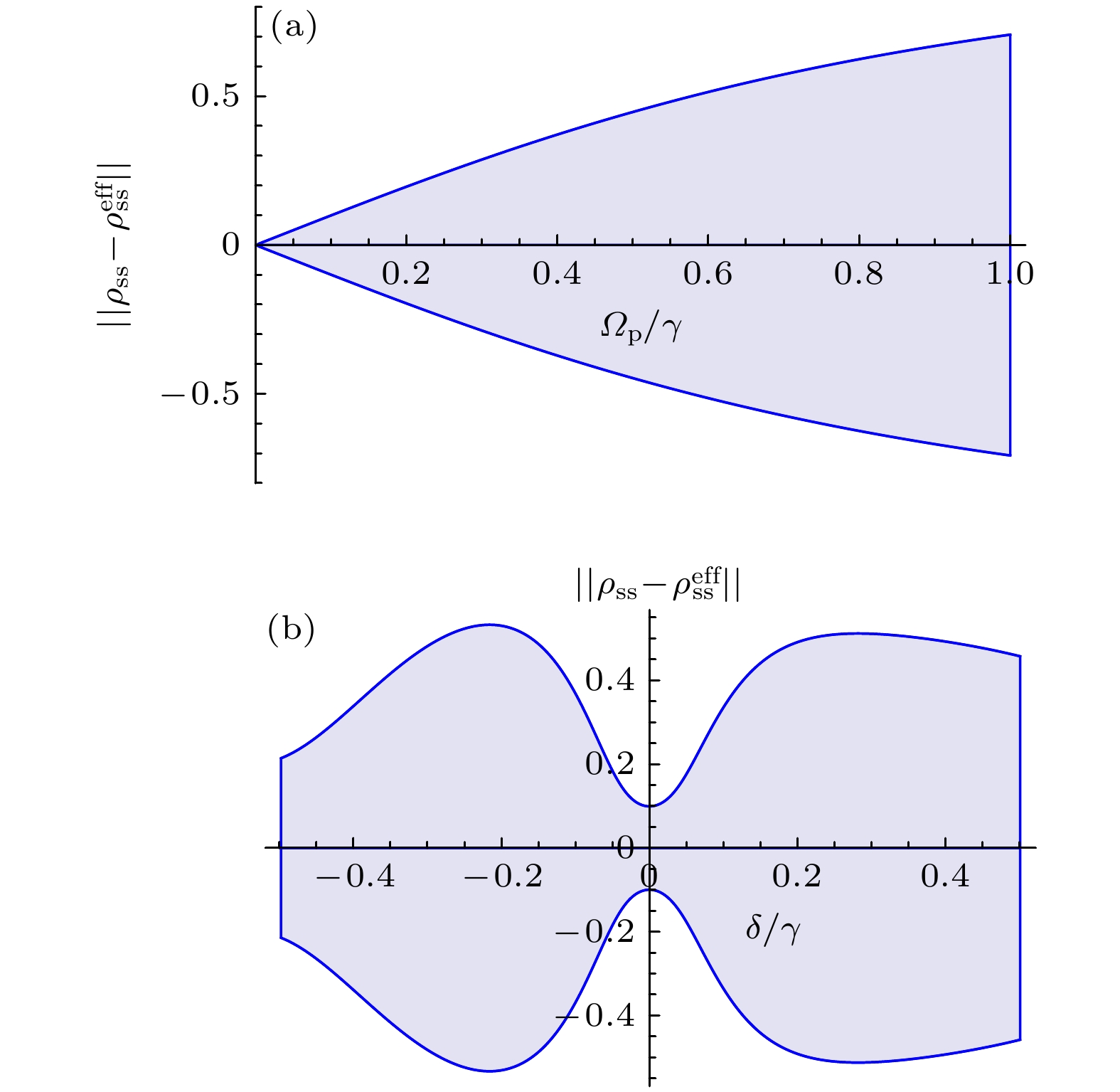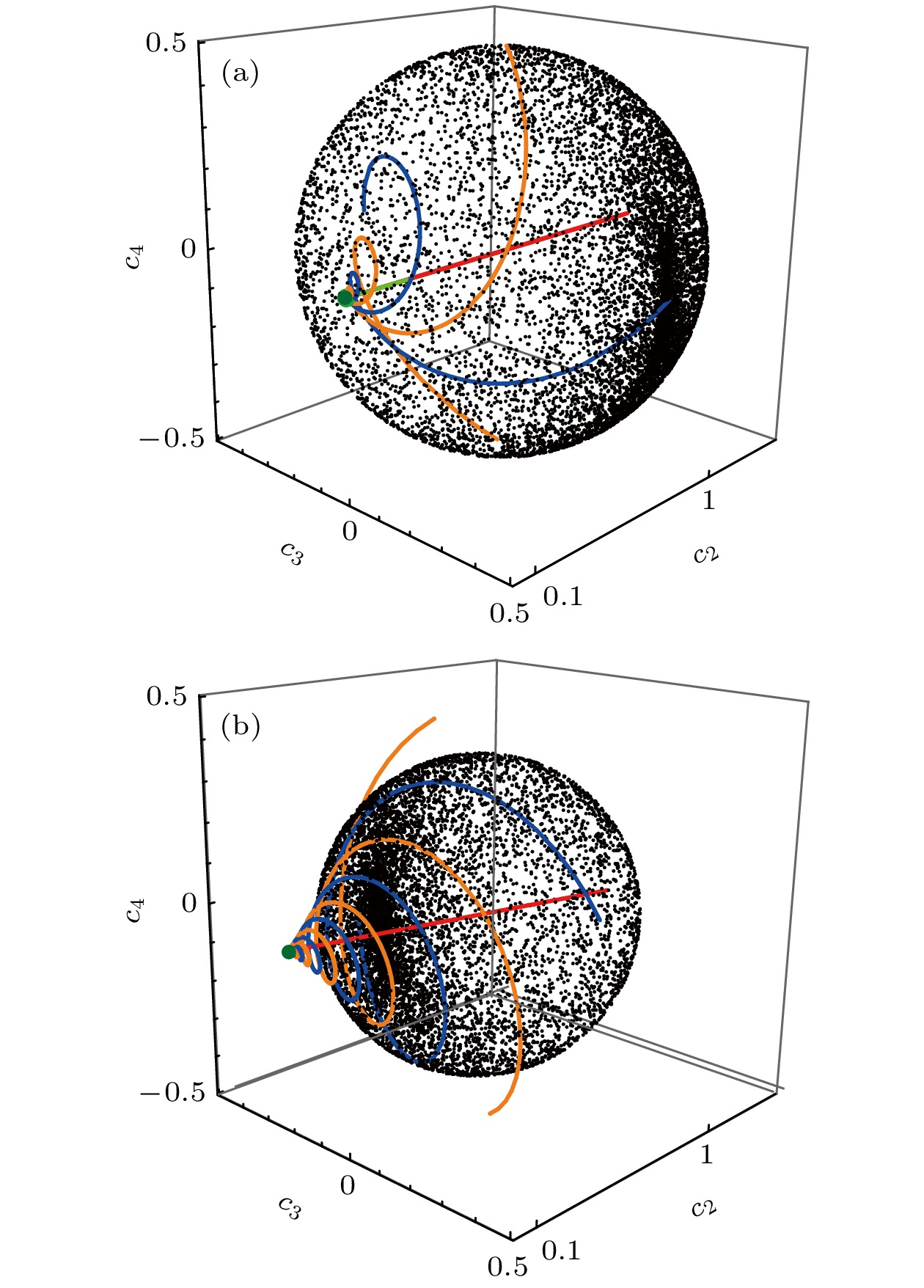-
开放量子系统是新兴量子科技不可或缺的量子平台, 也是量子物理中非常重要的研究领域, 其中丰富的动力学现象引起了人们广泛的关注. 例如, 某些情况下系统在弛豫至稳态之前一般会经历漫长的动力学过程, 即亚稳动力学过程. 完整描述这种复杂而又缓慢的动力学过程往往非常困难. 针对该问题, 本文研究了如何在刘维尔的慢变本征模式子空间中对亚稳动力学过程进行低维度的近似描述, 从而简化计算难度. 然后, 针对电磁感应透明条件下的里德伯原子系统, 研究了其亚稳动力学过程的有效描述, 并讨论了该有效描述和真实动力学之间的误差. 本文的研究为建立开放多体系统动力学过程的有效简化描述提供了一种可行的思路和方法.Open quantum system, coupled with an external bath is a key research field of quantum physics. Steady state is the state in which any initial state converges after a long time and is usually of the most interest. However, relatively speaking, the nonequilibrium dynamical processes of quantum many-body systems have been rarely studied. This is mainly due to the fact that quantum many-body systems generally have interactions, and the Hilbert space required for a complete description of their dynamical processes will grow exponentially with the number of particles increasing, and the computational difficulty will increase dramatically as well. Hence, it is a difficult problem to completely describe their dynamical processes completely. With the development of quantum technologies, the interest in the nonequilibrium dynamics of open quantum many-body systems is aroused. A common phenomenon is the metastable state, where the system initially relaxes into a long-lived state and then converges to the final stationary state for a longer time. In this paper, we establish a low-dimensional approximation to describe the metastability dynamics in Markovian open quantum system, based on the spectra of the Liouvillian super-operator. The separation of time scales implies a splitting in the spectrum, and this spectral division allows us to eliminate the fast decay modes by using the perturbation method, and then we establish the effective description in the low-lying eigenmodes subspace. Furthermore, we study the dynamics process of the Rydberg atomic system under electromagnetically induced transparency (EIT) conditions and find that the system can handle metastable dynamics if the atomic interactions are considered. We compare the effective dynamics in the subspace with the actual dynamics in the full space, and the results show that the effective dynamics works well on condition that the perturbation approximation holds. Our work provides a feasible idea and method for establishing an effective and simplified description of the dynamical process of open quantum many-body systems.
-
Keywords:
- metastable dynamics /
- relaxation /
- electromagnetically induced transparency /
- Liouvillian superoperator
[1] 翟荟 2023 物理学报 72 230701
 Google Scholar
Google Scholar
Zhai H 2023 Acta Phys. Sin. 72 230701
 Google Scholar
Google Scholar
[2] Macieszczak K, Guţă M, Lesanovsky I, Garrahan J P 2016 Phys. Rev. Lett. 116 240404
 Google Scholar
Google Scholar
[3] Defenu N 2021 Proc. Natl. Acad. Sci. 118 e2101785118
 Google Scholar
Google Scholar
[4] Macieszczak K, Rose D C, Lesanovsky I, Garrahan J P 2021 Phys. Rev. Res. 3 033047
 Google Scholar
Google Scholar
[5] Mori T 2021 Phys. Rev. Res. 3 043137
 Google Scholar
Google Scholar
[6] Li J L, Rose D C, Garrahan J P, Luitz D J 2022 Phys. Rev. B 105 L180201
 Google Scholar
Google Scholar
[7] Jäger S B, Schmit T, Morigi G, Holland M J, Betzholz R 2022 Phys. Rev. Lett. 129 063601
 Google Scholar
Google Scholar
[8] Gangat A A, Te I, Kao Y J 2017 Phys. Rev. Lett. 119 010501
 Google Scholar
Google Scholar
[9] Berthier L, Ediger M D 2016 Phys. Today 69 40
 Google Scholar
Google Scholar
[10] Macieszczak K, Zhou Y L, Hofferberth S, Garrahan J P, Li W B, Lesanovsky I 2017 Phys. Rev. A 96 043860
 Google Scholar
Google Scholar
[11] Brown C A, Macieszczak K, Jack R L 2024 Phys. Rev. A 109 022244
 Google Scholar
Google Scholar
[12] Letscher F, Thomas O, Niederprüm T, Fleischhauer M, Ott H 2017 Phys. Rev. X 7 021020
 Google Scholar
Google Scholar
[13] Cabot A, Carollo F, Lesanovsky I 2022 Phys. Rev. B 106 134311
 Google Scholar
Google Scholar
[14] Landa H, Schiró M, Misguich G 2020 Phys. Rev. Lett. 124 043601
 Google Scholar
Google Scholar
[15] Žnidarič M 2015 Phys. Rev. E 92 042143
 Google Scholar
Google Scholar
[16] Sciolla B, Poletti D, Kollath C 2015 Phys. Rev. Lett. 114 170401
 Google Scholar
Google Scholar
[17] Minganti F, Biella A, Bartolo N, Ciuti C 2018 Phys. Rev. A 98 042118
 Google Scholar
Google Scholar
[18] Zhou Y L, Yu X D, Wu C W, Li X Q, Zhang J, Li W, Chen P X 2023 Phys. Rev. Res. 5 043036
 Google Scholar
Google Scholar
[19] Kielpinski D, Meyer V, Rowe M A, Sackett C A, Itano W M, Monroe C, Wineland D J 2001 Science 291 1013
 Google Scholar
Google Scholar
[20] Viola L, Fortunato E M, Pravia M A, Knill E, Laflamme R, Cory D G 2001 Science 293 2059
 Google Scholar
Google Scholar
[21] Lindblad G 1976 Commun. Math. Phys. 48 119
 Google Scholar
Google Scholar
[22] Gorini V, Kossakowski A, Sudarshan E C G 1976 J. Math. Phys. 17 821
 Google Scholar
Google Scholar
[23] Minganti F, Miranowicz A, Chhajlany R W, Nori F 2019 Phys. Rev. A 100 062131
 Google Scholar
Google Scholar
[24] Carollo F, Lasanta A, Lesanovsky I 2021 Phys. Rev. Lett. 127 060401
 Google Scholar
Google Scholar
[25] Huybrechts D, Minganti F, Nori F, Wouters M, Shammah N 2020 Phys. Rev. B 101 214302
 Google Scholar
Google Scholar
[26] Albert V V, Jiang L 2014 Phys. Rev. A 89 022118
 Google Scholar
Google Scholar
[27] Zhang J, Xia G, Wu C W, Chen T, Zhang Q, Xie Y, Su W B, Wu W, Qiu C W, Chen P X, Li W B, Jing H, Zhou Y L 2024 arxiv: 2401.15951 [quant-ph]
[28] Zanardi P, Venuti L C 2015 Phys. Rev. A 91 052324
 Google Scholar
Google Scholar
[29] Marcuzzi M, Schick J, Olmos B, Lesanovsky I 2014 J. Phys. A 47 482001
 Google Scholar
Google Scholar
[30] Gutiérrez R, Garrahan J P, Lesanovsky I 2016 New J. Phys. 18 093054
 Google Scholar
Google Scholar
[31] Li W, Viscor D, Hofferberth S, Lesanovsky I 2014 Phys. Rev. Lett. 112 243601
 Google Scholar
Google Scholar
[32] Zhou Y L 2021 Opt. Express 29 15300
 Google Scholar
Google Scholar
-
图 1 双原子系统的亚稳态动力学过程示意图 (a)四能级原子的能级结构与光场激发构型图; (b)系统的动力学过程, 其中红色曲线对应图(c)中的参数条件, 蓝色曲线对应图(d)中的参数条件; (c), (d)刘维尔超算子的能谱, 红色点表示稳态所对应的本征值($ \lambda_0=0 $), 绿色点表示衰减模式所对应的本征值($ \lambda_{i > 0} $), 其中图(c)中无相互作用$ V/\gamma=0 $, 图(d)中相互作用$ V/\gamma=0.6 $, 其他参数均为$ \varOmega_{\mathrm{c}}/\gamma=2.0 $, $ \varOmega_{\mathrm{p}}/\gamma=0.1 $, $ \delta/\gamma=0 $
Fig. 1. Metastable dynamics of two-atom system: (a) Energy levels and transitions of four-levels atom; (b) the dynamic process of the system, where the red and blue curves correspond to the parameters in panels (c) and (d) respectively; (c), (d) the spectrum of the Liouvillian superoperator, the red points indicate the eigenvalue $ \lambda_0= 0 $ corresponding to the steady state, and the green points are the eigenvalues ($ \lambda_{i > 0} $) corresponding to the decaying mode, note that there is no interaction in panel (c) and $ V/\gamma=0 $, while the interaction in panel (d) with parameter $ V/\gamma=0.6 $, other parameters are $ \varOmega_{\mathrm{c}}/\gamma=2.0 $, $ \varOmega_{\mathrm{p}}/\gamma=0.1 $, $ \delta/\gamma=0 $.
图 2 刘维尔能谱随相互作用 $ V/\gamma $ 的变化. 参数 $ \varOmega_{\mathrm{c}}/\gamma=2.0 $, $ \varOmega_{\mathrm{p}}/\gamma=0.1 $, $ \delta/\gamma=0 $
Fig. 2. Spectrum of the Liouvillian as a function of $ V/\gamma $. Parameters are $ \varOmega_{\mathrm{c}}/\gamma=2.0 $, $ \varOmega_{\mathrm{p}}/\gamma=0.1 $, $ \delta/\gamma=0 $.
图 3 50种随机初始态情况下保真度$ F(t) = {{\rm{Tr}}}[\sqrt{\rho(t)\rho_ {\rm{eff}}(t)}] $随时间的变化. 横轴上的红色空心圆、红色实心圆和黑色方块所标注的时间分别对应于文中所定义的时间尺度$ \tau'', $$ \tau', \tau $ (a) $ \varOmega_{\mathrm{p}}/\gamma=0.2 $; (b) $ \varOmega_{\mathrm{p}}/\gamma=0.5 $. 其他参数为$ \varOmega_{\mathrm{c}}/\gamma=2.0 $, $ \delta/\gamma=0 $, $ V/\gamma=0.6 $
Fig. 3. Fidelity $ F(t) = {{\rm{Tr}}}[\sqrt{\rho(t)\rho_ {\rm{eff}}(t)}] $ in 50 random initial states. Red open circles, red filled circles and black squares on the x axis correspond the time scales $ \tau'', \tau', \tau $ respectively: (a) $ \varOmega_{\mathrm{p}}/\gamma=0.2 $; (b) $ \varOmega_{\mathrm{p}}/\gamma= 0.5 $. Other parameters are $ \varOmega_{\mathrm{c}}/\gamma=2.0 $, $ \delta/\gamma=0 $, $ V/\gamma=0.6 $.
图 4 有效动力学的稳态与真实稳态的差异, $ ||\delta \rho_{{\mathrm{ss}}}|| = $$ ||\rho_{{\mathrm{ss}}}-\rho_{{\mathrm{ss}}}^ {\rm{eff}}|| $随$ \varOmega_{\mathrm{p}}/\gamma $和δ/γ的变化, 其他参数同图3
Fig. 4. Difference between the steady state of the effective dynamics and the real steady state, $ ||\delta \rho_{{\mathrm{ss}}}|| = ||\rho_{{\mathrm{ss}}}-\rho_{{\mathrm{ss}}}^ {\rm{eff}}|| $ as a function of parameters $ \varOmega_{\mathrm{p}} /\gamma$ and δ/γ, other parameters are the same as Fig.3.
图 5 不同初始态在慢变子空间的动力学演化 (a) $ \varOmega_{\mathrm{p}}/\gamma= $$ 0.1$; (b) $ \varOmega_{\mathrm{p}}/\gamma=0.6$. 其他参数同图3. 图中黑色的小点表示子空间中的任意纯态, 绿色圆点表示系统最终的稳态, 红色、蓝色、橙色和绿色曲线表示从几种不同的初始态开始的动力学过程
Fig. 5. Dynamical evolution of different initial states in the metastabel subspace: (a) $ \varOmega_{\mathrm{p}}/\gamma=0.1 $; (b) $ \varOmega_{\mathrm{p}}/\gamma=0.6$. Otherparamet-ers are the same as Fig.3. Black dots indicate arbitrary pure states in the subspace, the green dot indicates the steady state of the system, and the red, blue, orange and green curves indicate the dynamical processes starting from several different initial states.
-
[1] 翟荟 2023 物理学报 72 230701
 Google Scholar
Google Scholar
Zhai H 2023 Acta Phys. Sin. 72 230701
 Google Scholar
Google Scholar
[2] Macieszczak K, Guţă M, Lesanovsky I, Garrahan J P 2016 Phys. Rev. Lett. 116 240404
 Google Scholar
Google Scholar
[3] Defenu N 2021 Proc. Natl. Acad. Sci. 118 e2101785118
 Google Scholar
Google Scholar
[4] Macieszczak K, Rose D C, Lesanovsky I, Garrahan J P 2021 Phys. Rev. Res. 3 033047
 Google Scholar
Google Scholar
[5] Mori T 2021 Phys. Rev. Res. 3 043137
 Google Scholar
Google Scholar
[6] Li J L, Rose D C, Garrahan J P, Luitz D J 2022 Phys. Rev. B 105 L180201
 Google Scholar
Google Scholar
[7] Jäger S B, Schmit T, Morigi G, Holland M J, Betzholz R 2022 Phys. Rev. Lett. 129 063601
 Google Scholar
Google Scholar
[8] Gangat A A, Te I, Kao Y J 2017 Phys. Rev. Lett. 119 010501
 Google Scholar
Google Scholar
[9] Berthier L, Ediger M D 2016 Phys. Today 69 40
 Google Scholar
Google Scholar
[10] Macieszczak K, Zhou Y L, Hofferberth S, Garrahan J P, Li W B, Lesanovsky I 2017 Phys. Rev. A 96 043860
 Google Scholar
Google Scholar
[11] Brown C A, Macieszczak K, Jack R L 2024 Phys. Rev. A 109 022244
 Google Scholar
Google Scholar
[12] Letscher F, Thomas O, Niederprüm T, Fleischhauer M, Ott H 2017 Phys. Rev. X 7 021020
 Google Scholar
Google Scholar
[13] Cabot A, Carollo F, Lesanovsky I 2022 Phys. Rev. B 106 134311
 Google Scholar
Google Scholar
[14] Landa H, Schiró M, Misguich G 2020 Phys. Rev. Lett. 124 043601
 Google Scholar
Google Scholar
[15] Žnidarič M 2015 Phys. Rev. E 92 042143
 Google Scholar
Google Scholar
[16] Sciolla B, Poletti D, Kollath C 2015 Phys. Rev. Lett. 114 170401
 Google Scholar
Google Scholar
[17] Minganti F, Biella A, Bartolo N, Ciuti C 2018 Phys. Rev. A 98 042118
 Google Scholar
Google Scholar
[18] Zhou Y L, Yu X D, Wu C W, Li X Q, Zhang J, Li W, Chen P X 2023 Phys. Rev. Res. 5 043036
 Google Scholar
Google Scholar
[19] Kielpinski D, Meyer V, Rowe M A, Sackett C A, Itano W M, Monroe C, Wineland D J 2001 Science 291 1013
 Google Scholar
Google Scholar
[20] Viola L, Fortunato E M, Pravia M A, Knill E, Laflamme R, Cory D G 2001 Science 293 2059
 Google Scholar
Google Scholar
[21] Lindblad G 1976 Commun. Math. Phys. 48 119
 Google Scholar
Google Scholar
[22] Gorini V, Kossakowski A, Sudarshan E C G 1976 J. Math. Phys. 17 821
 Google Scholar
Google Scholar
[23] Minganti F, Miranowicz A, Chhajlany R W, Nori F 2019 Phys. Rev. A 100 062131
 Google Scholar
Google Scholar
[24] Carollo F, Lasanta A, Lesanovsky I 2021 Phys. Rev. Lett. 127 060401
 Google Scholar
Google Scholar
[25] Huybrechts D, Minganti F, Nori F, Wouters M, Shammah N 2020 Phys. Rev. B 101 214302
 Google Scholar
Google Scholar
[26] Albert V V, Jiang L 2014 Phys. Rev. A 89 022118
 Google Scholar
Google Scholar
[27] Zhang J, Xia G, Wu C W, Chen T, Zhang Q, Xie Y, Su W B, Wu W, Qiu C W, Chen P X, Li W B, Jing H, Zhou Y L 2024 arxiv: 2401.15951 [quant-ph]
[28] Zanardi P, Venuti L C 2015 Phys. Rev. A 91 052324
 Google Scholar
Google Scholar
[29] Marcuzzi M, Schick J, Olmos B, Lesanovsky I 2014 J. Phys. A 47 482001
 Google Scholar
Google Scholar
[30] Gutiérrez R, Garrahan J P, Lesanovsky I 2016 New J. Phys. 18 093054
 Google Scholar
Google Scholar
[31] Li W, Viscor D, Hofferberth S, Lesanovsky I 2014 Phys. Rev. Lett. 112 243601
 Google Scholar
Google Scholar
[32] Zhou Y L 2021 Opt. Express 29 15300
 Google Scholar
Google Scholar
计量
- 文章访问数: 3724
- PDF下载量: 104
- 被引次数: 0













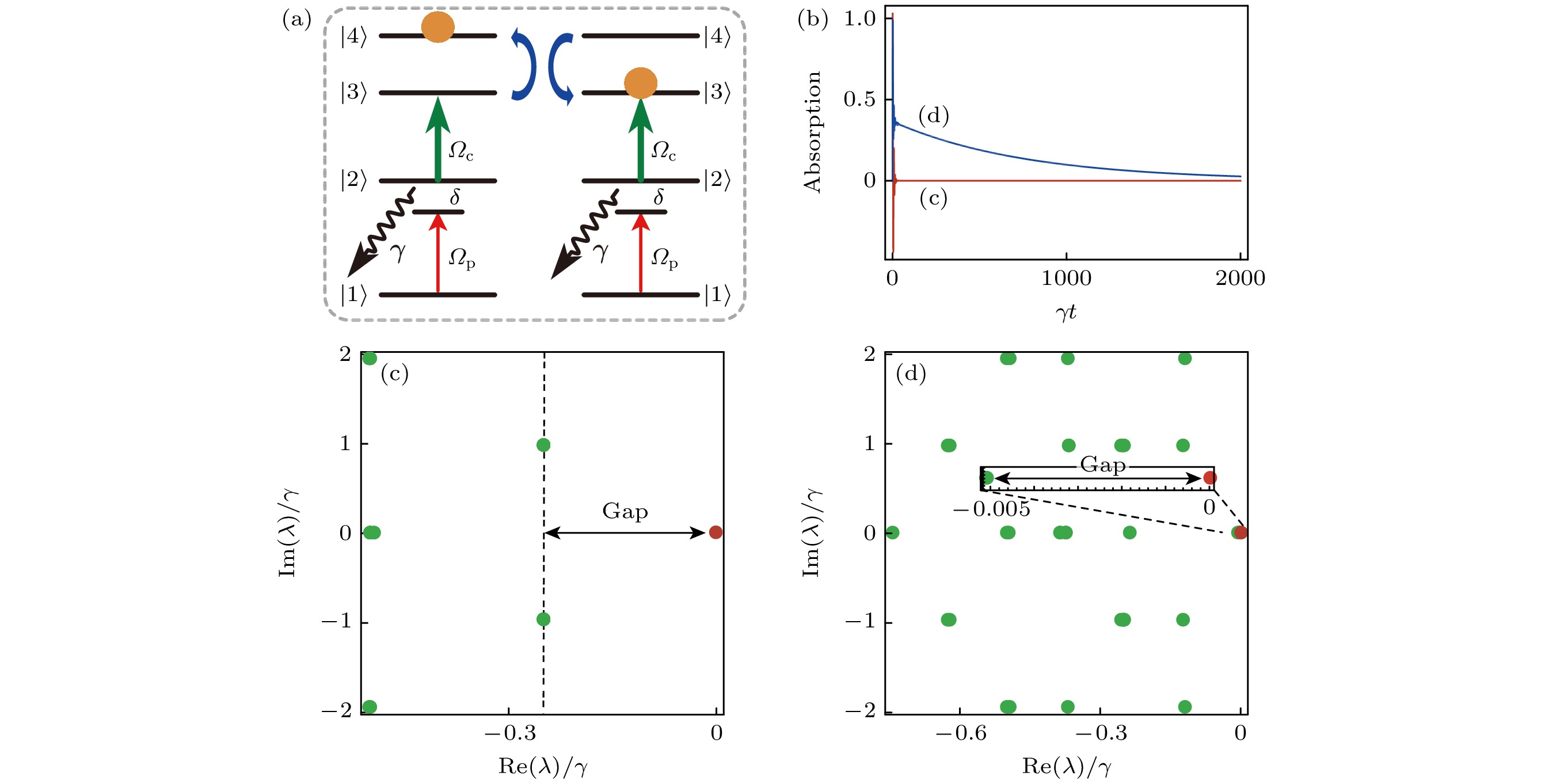
 下载:
下载:
